 Black Panther #6 — Writer: Ta-Nehisi Coates; Pencils: Chris Sprouse; Inks: Karl Story; Colors: Laura Martin
Black Panther #6 — Writer: Ta-Nehisi Coates; Pencils: Chris Sprouse; Inks: Karl Story; Colors: Laura Martin
Scarlet Witch #10 — Writer: James Robinson; Art: Kei Zama; Colors: Ian Herring
Spider-Man #8 — Writer: Brian Michael Bendis; Art: Nico Leon; Colors: Marte Gracia
Only a couple of Marvel books to note this time — after a few light weeks, the DC “Rebirth” issues are back to sucking all the oxygen out of the room. Black Panther is probably Coates’s best issue yet, because it’s reached that turn-around point where, after the hero has been beaten  down and seemingly lost his way, he turns out to still have some of those old T’Challa smartest-guy-in-the-room tricks up his sleeve after all — and a group of allies who name-check an obscure branch of former Panther scribe Christopher Priest’s Marvel history, too. More recent Panther fans will be particularly interested in one of the quartet of guest-stars who appear on the issue’s last page, too, and promise to jump-start the book’s next chapter. Scarlet Witch continues its series of stand-alone stories, each issue featuring an up-and-coming woman artist; this issue’s spotlight is on Kei Zama, who illustrates a tale set in Japan, about Wanda searching for the murderer of a famed Kyoto warlock; she offers some austere winter
down and seemingly lost his way, he turns out to still have some of those old T’Challa smartest-guy-in-the-room tricks up his sleeve after all — and a group of allies who name-check an obscure branch of former Panther scribe Christopher Priest’s Marvel history, too. More recent Panther fans will be particularly interested in one of the quartet of guest-stars who appear on the issue’s last page, too, and promise to jump-start the book’s next chapter. Scarlet Witch continues its series of stand-alone stories, each issue featuring an up-and-coming woman artist; this issue’s spotlight is on Kei Zama, who illustrates a tale set in Japan, about Wanda searching for the murderer of a famed Kyoto warlock; she offers some austere winter 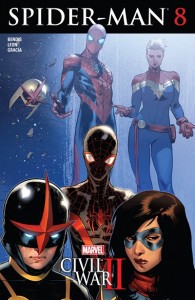 images of that city, a beautiful, just-slightly-manga Wanda, a sharply-drawn, and plot-significant, fox, and a demon; mix in Ian Herring’s just-right coloring and the even-more-striking-than-usual David Aja cover, and this is another in a long series of successful issues for this title. Spider-Man, meanwhile, sees Miles approached by Luke Cage and Jessica Jones, who yell at him about his carelessness in concealing his secret identity; then, we see him, Ms. Marvel and Nova’s take on the Hawkeye-kills-Bruce-Banner sequnce, an obvious setup for the coming Champions book that the trio will be starring in soon. Since Spider-Man is by Civil War II author Bendis, it’s a close tie-in to that title, with enough good character bits and drama to make it worthwhile.
images of that city, a beautiful, just-slightly-manga Wanda, a sharply-drawn, and plot-significant, fox, and a demon; mix in Ian Herring’s just-right coloring and the even-more-striking-than-usual David Aja cover, and this is another in a long series of successful issues for this title. Spider-Man, meanwhile, sees Miles approached by Luke Cage and Jessica Jones, who yell at him about his carelessness in concealing his secret identity; then, we see him, Ms. Marvel and Nova’s take on the Hawkeye-kills-Bruce-Banner sequnce, an obvious setup for the coming Champions book that the trio will be starring in soon. Since Spider-Man is by Civil War II author Bendis, it’s a close tie-in to that title, with enough good character bits and drama to make it worthwhile.
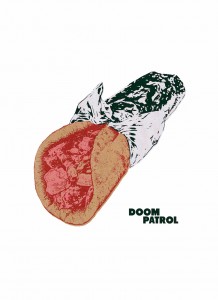 Doom Patrol #1 — Writer: Gerald Way; Art: Nick Derington; Colors: Tamra Bonvillain
Doom Patrol #1 — Writer: Gerald Way; Art: Nick Derington; Colors: Tamra Bonvillain
Deathstroke #2 — Writer: Christopher Priest; Breakdowns: Larry Hama; Pencils: Carlos Pagulayan; Inks: Jason Paz; Colors: Jeromy Cox
Astro City #38 — Writer: Kurt Busiek; Art: Brent Anderson; Colors: Peter Pantazis
As I said, lots of DC books this week, many of them related to franchise characters like Batman, Superman or Green Lantern. Of the non-affiliated titles, Doom Patrol is the most interesting — it’s a callback, not to the original ’60s series, but to the ’90s Grant Morrison incarnation: surreal, whip-fast, and funny and disturbing in equal amounts. It’s the first of DC’s new “Young Animal” imprint, and written by that line’s showrunner, Gerard Way, known to the world at large as a musician — My Chemical Romance — but known to comics fans for writing the comic series Umbrella Academy and Killjoys. The Young Animal line clearly aspires to be for 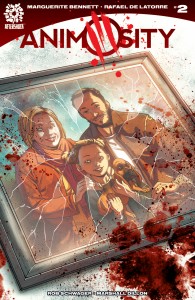 hip kids in the ’10s what Vertigo was for that group in the ’90s, and Doom Patrol sets the pattern: the first issue is confusing, with the introduction of a bunch of characters — spunky EMTs, evil alien entrepreneurs, singing birthday-greeting deliverers who make people explode — and lots of brief name-checks of earlier continuity — Cliff “Robotman” Steele shows up, and Niles Caulder’s there for a page, and Danny the Street plays a pivotal role — but it’s a fascinating, fizzy, brightly-colored carnival ride, and assuming that it all connects together eventually, it’s got a ton of potential. Lots of variant covers, but the main one — with a scratch-and-sniff gyro that’s actually significant to the plot inside — and the Jaime Hernandez one are the two to look for. Deathstroke also plays with narration — it’s got the trademark Christopher Priest series of one- and two-page individually-titled blackout scenes, in between the longer, more normal ones — but it’s a lot more understandable and self-contained, with a plot involving Slade’s old cronies and ex-wife and kids, and detailed art by Pagulayan that’s got some of the weight and intensity of Priest’s longtime collaborator
hip kids in the ’10s what Vertigo was for that group in the ’90s, and Doom Patrol sets the pattern: the first issue is confusing, with the introduction of a bunch of characters — spunky EMTs, evil alien entrepreneurs, singing birthday-greeting deliverers who make people explode — and lots of brief name-checks of earlier continuity — Cliff “Robotman” Steele shows up, and Niles Caulder’s there for a page, and Danny the Street plays a pivotal role — but it’s a fascinating, fizzy, brightly-colored carnival ride, and assuming that it all connects together eventually, it’s got a ton of potential. Lots of variant covers, but the main one — with a scratch-and-sniff gyro that’s actually significant to the plot inside — and the Jaime Hernandez one are the two to look for. Deathstroke also plays with narration — it’s got the trademark Christopher Priest series of one- and two-page individually-titled blackout scenes, in between the longer, more normal ones — but it’s a lot more understandable and self-contained, with a plot involving Slade’s old cronies and ex-wife and kids, and detailed art by Pagulayan that’s got some of the weight and intensity of Priest’s longtime collaborator  Mark Bright; there’s a two-page sequence of Deathstroke fighting two assassins that’s intense and well-choreographed, an encouraging sign that this relaunch is going to be equal parts brains and blood, with many connections to previous continuity. That leaves Astro City, the second of a two-parter about an urban spirit who’s the embodiment of music (it’s set in the jazz-era 1920s, and the spirit manifests as a glowing flapper girl; in the previous issue, set a decade or so earlier, it was a male minstrel-show player), and adds a couple of new threads to the book’s rich tapestry about the title city, with Busiek and Anderson providing their normal stellar collaboration in art and story.
Mark Bright; there’s a two-page sequence of Deathstroke fighting two assassins that’s intense and well-choreographed, an encouraging sign that this relaunch is going to be equal parts brains and blood, with many connections to previous continuity. That leaves Astro City, the second of a two-parter about an urban spirit who’s the embodiment of music (it’s set in the jazz-era 1920s, and the spirit manifests as a glowing flapper girl; in the previous issue, set a decade or so earlier, it was a male minstrel-show player), and adds a couple of new threads to the book’s rich tapestry about the title city, with Busiek and Anderson providing their normal stellar collaboration in art and story.
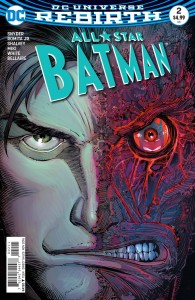 All-Star Batman #2 — Writer: Scott Snyder; Pencils: John Romita Jr.; Inks: Danny Miki; Colors: Dean White
All-Star Batman #2 — Writer: Scott Snyder; Pencils: John Romita Jr.; Inks: Danny Miki; Colors: Dean White
Detective #940 — Writer: James Tynion IV; Pencils: Eddy Barrows; Inks: Eber Ferreira; Colors: Adriano Lucas
Batgirl and the Birds of Prey #2 — Writers: Julie Benson and Shawna Benson; Art: Claire Roe and Roge Antonio; Colors: Allen Passalaqua and Hi-Fi
Three Batman family books, with All-Star Batman the most-anticipated; Scott Snyder’s been writing super-popular Bat-stories since before the New 52 began, and of course John Romita Jr. makes any character look good — see his run last year on Superman, which helped make the Man of Steel more interesting 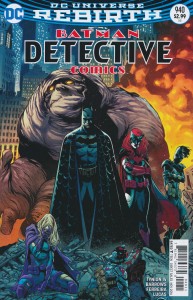 than he’s been in any book not written by Grant Morrison for decades. This first arc, featuring Two-Face, involves the usual Snyder Big Plot Points — in this case, Jim Gordon and Harvey Bullock going to Wayne Mansion, apparently to expose Bruce as Batman. Will that really happen? Since the All-Star books sidestep current continuity, it’s hard to believe that any change that big would stick, but Snyder’s talent is that he makes us believe that it might, and so we have to keep reading to find out what happens next: that’s the definition of a good pulp writer. Something similar is going on in Detective, the Bat-book that’s reminiscent of Batman and the Outsiders, in that the Caped Crusader has assembled a team of Gotham heroes, led by Batwoman, to help him in his campaign against the bad guys. There’ve been rumors that one of their members will die this issue (hint: who’s not on the cover
than he’s been in any book not written by Grant Morrison for decades. This first arc, featuring Two-Face, involves the usual Snyder Big Plot Points — in this case, Jim Gordon and Harvey Bullock going to Wayne Mansion, apparently to expose Bruce as Batman. Will that really happen? Since the All-Star books sidestep current continuity, it’s hard to believe that any change that big would stick, but Snyder’s talent is that he makes us believe that it might, and so we have to keep reading to find out what happens next: that’s the definition of a good pulp writer. Something similar is going on in Detective, the Bat-book that’s reminiscent of Batman and the Outsiders, in that the Caped Crusader has assembled a team of Gotham heroes, led by Batwoman, to help him in his campaign against the bad guys. There’ve been rumors that one of their members will die this issue (hint: who’s not on the cover  image up to the right there, the one with Sad Clayface on it?) — are they true? No spoilers here, except to say that it’s done well, with enough twists to keep everyone on their toes, and a tie-in to the meta-story about the origins of “Rebirth” itself — reason enough to check it out. Batgirl and the Birds of Prey continues its first arc, as Barbara and Dinah get to know The Huntress, and team up to hunt for the mysterious new player who’s calling herself (himself?) Oracle, leading to confrontations with a number of bad guys. The Bensons, and Roe, do a good job of combining female empowerment (and conversation) with lots of action, in a way that should satisfy both new and older readers.
image up to the right there, the one with Sad Clayface on it?) — are they true? No spoilers here, except to say that it’s done well, with enough twists to keep everyone on their toes, and a tie-in to the meta-story about the origins of “Rebirth” itself — reason enough to check it out. Batgirl and the Birds of Prey continues its first arc, as Barbara and Dinah get to know The Huntress, and team up to hunt for the mysterious new player who’s calling herself (himself?) Oracle, leading to confrontations with a number of bad guys. The Bensons, and Roe, do a good job of combining female empowerment (and conversation) with lots of action, in a way that should satisfy both new and older readers.
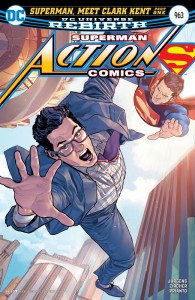 Action Comics #963 — Writer: Dan Jurgens; Art: Patrick Zircher; Colors: Arif Prianto
Action Comics #963 — Writer: Dan Jurgens; Art: Patrick Zircher; Colors: Arif Prianto
Superwoman #2 — Writer/Pencils: Phil Jimenez; Inks: Matt Santorelli and Joe Prado; Colors: Jeromy Cox
New Super-Man #3 — Writer: Gene Luen Yang; Pencils: Viktor Bogdanovic; Inks: Richard Friend; Colors: Hi-Fi
The Superman Family’s got three books out this week, too — although Action‘s the only one with Superman himself, as the mystery of a Clark Kent who’s not the Man of Steel, and never has been, deepens; it’s fun 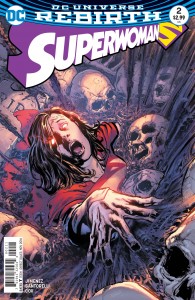 watching the creative team yank our chains while they play out the plot threads and make us wonder what’s going on. Superwoman‘s first issue benefited from a game-changing shock, a major and unexpected character death, although in retrospect it’s one of those clean-up-continuity developments that’s we should have seen coming; this issue follows the aftereffects, as Lana Lang, gifted with super-powers when the previous version of Superman died (boy, if you’re a fan coming back to DC after a few years away, you’re going to be way behind…), teams up with John Henry “Steel” Irons (now her husband… yep, you returning readers have missed a lot…), niece Natasha, Maggie Sawyer and other familiar characters to solve the mystery of the “other” Superwoman’s death. Not
watching the creative team yank our chains while they play out the plot threads and make us wonder what’s going on. Superwoman‘s first issue benefited from a game-changing shock, a major and unexpected character death, although in retrospect it’s one of those clean-up-continuity developments that’s we should have seen coming; this issue follows the aftereffects, as Lana Lang, gifted with super-powers when the previous version of Superman died (boy, if you’re a fan coming back to DC after a few years away, you’re going to be way behind…), teams up with John Henry “Steel” Irons (now her husband… yep, you returning readers have missed a lot…), niece Natasha, Maggie Sawyer and other familiar characters to solve the mystery of the “other” Superwoman’s death. Not 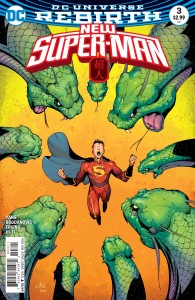 much is revealed, but the soap-opera stuff is effective at keeping us wondering, and reading. New Super-Man pulls much the same trick, with a number of subplots and new characters bubbling on the stove, as China’s homegrown version of the Man of Steel, young, untested and naive, tries to learn his super-hero craft with the similarly-created Oriental versions of Batman and Wonder Woman. This book is still benefiting from the shock of its exotic new setting and personnel; three issues in, it remains in “origin” mode, and we’ll have to give it another few months to see what kind of style and angle it’ll settle on before making any final judgements about it..
much is revealed, but the soap-opera stuff is effective at keeping us wondering, and reading. New Super-Man pulls much the same trick, with a number of subplots and new characters bubbling on the stove, as China’s homegrown version of the Man of Steel, young, untested and naive, tries to learn his super-hero craft with the similarly-created Oriental versions of Batman and Wonder Woman. This book is still benefiting from the shock of its exotic new setting and personnel; three issues in, it remains in “origin” mode, and we’ll have to give it another few months to see what kind of style and angle it’ll settle on before making any final judgements about it..
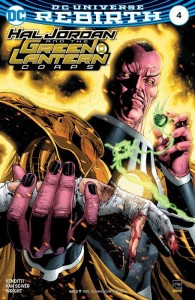 Hal Jordan and the Green Lantern Corps #4 — Writer: Robert Venditti; Art: Ethan Van Sciver; Colors: Jason Wright
Hal Jordan and the Green Lantern Corps #4 — Writer: Robert Venditti; Art: Ethan Van Sciver; Colors: Jason Wright
Green Lanterns #6 — Writer: Sam Humphries; Art: Will Conrad and Jack Herbert; Colors: Blond
Two Green Lantern books, one with all the “old” Lanterns in space against the now-dominant Sinestro Corps, and one with the two “new” ones on Earth against the Red Lanterns. Hal Jordan… benefits from long-time Lantern illustrator van Sciver, who makes Hal, Sinestro, Guy Gardner and the others look suitably heroic, sinister and stubborn, repectively (and Sciver and colorist Wright do a good job of making all the yellow and green ring constructs look suitably cool, too), while the plot combines all those familiar 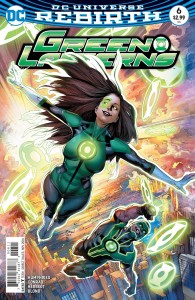 elements effectively, and should be attractive to old fans of the various GL-centric titles. Green Lanterns, meanwhile, already on issue #6 and finishing its first arc, ends up delivering a satisfying rookies-growing-under-fire story. It’s got one of those codas that sets up yet another GL epic in the future, the kind of thing that was compelling back when Geoff Johns was on the book and forecasting Blackest Night, but has lost a lot of its luster as wave after wave of Big Battles and events have followed it. Giving Jessica and Simon, the newbies, a year or two to catch their breaths, lighten the tone and fight some ground-level crooks for awhile might be nice (although I wouldn’t count on a return to the two-separate-stand-alone-storie-in-each-issue ’60s anytime soon…).
elements effectively, and should be attractive to old fans of the various GL-centric titles. Green Lanterns, meanwhile, already on issue #6 and finishing its first arc, ends up delivering a satisfying rookies-growing-under-fire story. It’s got one of those codas that sets up yet another GL epic in the future, the kind of thing that was compelling back when Geoff Johns was on the book and forecasting Blackest Night, but has lost a lot of its luster as wave after wave of Big Battles and events have followed it. Giving Jessica and Simon, the newbies, a year or two to catch their breaths, lighten the tone and fight some ground-level crooks for awhile might be nice (although I wouldn’t count on a return to the two-separate-stand-alone-storie-in-each-issue ’60s anytime soon…).
 Hadrian’s Wall #1 — Writers: Kyle Higgins and Alec Siegel; Art/Colors: Rod Reis
Hadrian’s Wall #1 — Writers: Kyle Higgins and Alec Siegel; Art/Colors: Rod Reis
Animosity #2 — Writer: Marguerite Bennett; Art: Rafael de Latorre; Colors: Rob Schwager
Lady Killer #2 — Writer/Artist: Joelle Jones; Colors: Michelle Madsen
The Black Monday Murders #2 — Writer: Jonathan Hickman; Art: Tomm Coker; Colors: Michael Garland
Briggs Land #2 — Writer: Brian Wood; Art: Mack Chatter;  Colors: Lee Loughridge
Colors: Lee Loughridge
One brand-new indy book, and a quartet of sophomore efforts. Hadrian’s Wall is from the team that produced C.O.W.L.; that was an alternate-history super-hero comic, while this one is sf: the title “wall” is actually a massive space ship, and after one of its sailors dies when his suit ruptures in space, an Earth investigator gets sent to see what happened. The kicker is that the dead man was married to the investigator’s ex-wife, who’s also on the ship, adding extra tensions to what’s already a deep-space murder mystery. Good for what it is, with Reis’s painterly art and coloring lending a lushness to the human figures and faces. Of the returning books, 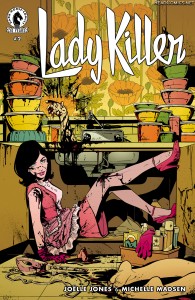 Animosity, about what happens when all animals, from lions to dogs to birds to mice, suddenly become self-aware, able to talk and with human-level intelligence, is already a hit, with its first issue having gone through a couple of printings. This second one extends the ramifications of the change — civilization collapses as there’s no longer any food but stuff you can grow, since killing an animal now amounts to murder — but keeps its focus on the little girl and her loyal basset hound who are the main characters. There’s some semi-confusing jumps ahead in time, but that’s meant to eliminate the parents, establish the new status quo and get the pair on the road: they’re in NYC, and the girl’s only family is now a brother in California, so a road trip across the country and through
Animosity, about what happens when all animals, from lions to dogs to birds to mice, suddenly become self-aware, able to talk and with human-level intelligence, is already a hit, with its first issue having gone through a couple of printings. This second one extends the ramifications of the change — civilization collapses as there’s no longer any food but stuff you can grow, since killing an animal now amounts to murder — but keeps its focus on the little girl and her loyal basset hound who are the main characters. There’s some semi-confusing jumps ahead in time, but that’s meant to eliminate the parents, establish the new status quo and get the pair on the road: they’re in NYC, and the girl’s only family is now a brother in California, so a road trip across the country and through 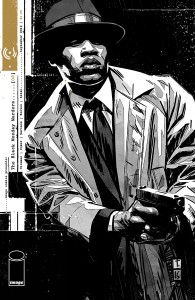 the apocalypse will form the spine of the narrative for a while. Imaginative and fascinating — often bloodily, with the casual violence of Bennett’s Insexts but with more humor than that book (talking pigs wear little Communist caps out of Animal Farm, and pass out pamphlets on “animalism”) — it deserves its already-cult status. Lady Killer continues Joelle Jones’s tale of a contract killer who’s also an early-’60s suburban housewife, with luscious art combining Hitchcockian homicides with Jackie Kennedy-style fashions, and a sly upending of that period’s sexual discrimination: its heroine is Betty Friedan, but with a dagger instead of a pen. The Black Monday Murders is Jonathan Hickman’s new ongoing series; it follows a black NYC detective investigating a murder in the financial industry — but, being Hickman, there’s also conspiracies reaching back millennia, non-linear
the apocalypse will form the spine of the narrative for a while. Imaginative and fascinating — often bloodily, with the casual violence of Bennett’s Insexts but with more humor than that book (talking pigs wear little Communist caps out of Animal Farm, and pass out pamphlets on “animalism”) — it deserves its already-cult status. Lady Killer continues Joelle Jones’s tale of a contract killer who’s also an early-’60s suburban housewife, with luscious art combining Hitchcockian homicides with Jackie Kennedy-style fashions, and a sly upending of that period’s sexual discrimination: its heroine is Betty Friedan, but with a dagger instead of a pen. The Black Monday Murders is Jonathan Hickman’s new ongoing series; it follows a black NYC detective investigating a murder in the financial industry — but, being Hickman, there’s also conspiracies reaching back millennia, non-linear 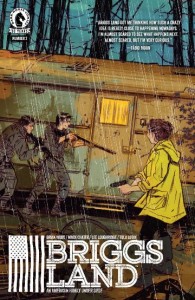 dimensional travel, and more, with the characters speaking in his trademark dialogue — marked by portentous asides in italics. This stuff is always fascinating, with Coker’s noirish art a good fit for all the paranoia and creepiness. Will it develop legs, like The Manhattan Project and East of West, or peter out like some of his other attempts? That leaves Briggs Land, about a family of survivalists/secessionists stretching back generations, and what happens when their patriarch ends up in jail and the wife takes charge, and then has to prevent a civil war among her clan. Smart and bleak, as Wood’s work often is, with uncomfortable parallels to current political events, and careful, detailed art from Chatter that keeps all the actions and multiple characters clear; this is another comic with some potential.
dimensional travel, and more, with the characters speaking in his trademark dialogue — marked by portentous asides in italics. This stuff is always fascinating, with Coker’s noirish art a good fit for all the paranoia and creepiness. Will it develop legs, like The Manhattan Project and East of West, or peter out like some of his other attempts? That leaves Briggs Land, about a family of survivalists/secessionists stretching back generations, and what happens when their patriarch ends up in jail and the wife takes charge, and then has to prevent a civil war among her clan. Smart and bleak, as Wood’s work often is, with uncomfortable parallels to current political events, and careful, detailed art from Chatter that keeps all the actions and multiple characters clear; this is another comic with some potential.
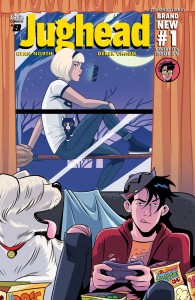 Jughead #9 — Writer: Ryan North; Art/Colors: Derek Charm
Jughead #9 — Writer: Ryan North; Art/Colors: Derek Charm
Cinema Purgatorio #5 — Creators: Various
Stray Bullets: Sunshine and Roses #18 — Creator: David Lapham
The more-established indy books: Jughead sees the debut of scripter Ryan North (Squirrel Girl), who kicks off his tenure with Pops Tate hiring a girl to dress up as a big hamburger and hand out free food coupons outside his store. To foodie Jughead, who’s always been fixated more on burgers than broads, she’s the perfect conversational  companion, and although all he can see are her head and hands, after weeks of repartee they end up agreeing to a date. She turns out to be… well, a surprise, although it’s totally spoiled by the cover (the second book this week to do that — the current issue of The Flash has a brand-new villain reveal his name after a three-page buildup at the end of the book — and it’s totally spoiled by the cover, too. What are editors thinking?), but even with the change in creative team this continues to be a hip, fun recreation of the classic Archie character. Cinema Purgatorio continues Alan Moore and Kevin O’Neill’s serial of creepily-off-kilter old movies, as played in a seedy theater in, yes, Purgatory (if you’re lucky….). There are also the usual chapters of Garth
companion, and although all he can see are her head and hands, after weeks of repartee they end up agreeing to a date. She turns out to be… well, a surprise, although it’s totally spoiled by the cover (the second book this week to do that — the current issue of The Flash has a brand-new villain reveal his name after a three-page buildup at the end of the book — and it’s totally spoiled by the cover, too. What are editors thinking?), but even with the change in creative team this continues to be a hip, fun recreation of the classic Archie character. Cinema Purgatorio continues Alan Moore and Kevin O’Neill’s serial of creepily-off-kilter old movies, as played in a seedy theater in, yes, Purgatory (if you’re lucky….). There are also the usual chapters of Garth 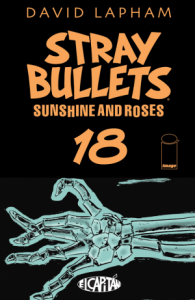 Ennis and Raulo Caceres’ EMT-to-the-supernatural Code Pru (with Do0m Patrol, this is the season for spunky-girl EMT’s), Max Brooks and Michael DiPascale’s giant-ant invasion/Civil War mashup A More Perfect Union, another mashup, this one of Pokemon tournaments and alien invasions, by Kieron Gillen and Ignacio Calero, and a giant-monster-apocalypse tale by Christos Gage and Gabriel Andrade. Stray Bullets doesn’t have all those creators — it’s just, always and forever, a product of David Lapham, and this episode has thieves-on-the-run Beth and her boyfriend and girlfriend showing up at her mother’s house, thus picking up character threads that were first laid down decades ago — the advantage of being your own producer, director, writer and artist.
Ennis and Raulo Caceres’ EMT-to-the-supernatural Code Pru (with Do0m Patrol, this is the season for spunky-girl EMT’s), Max Brooks and Michael DiPascale’s giant-ant invasion/Civil War mashup A More Perfect Union, another mashup, this one of Pokemon tournaments and alien invasions, by Kieron Gillen and Ignacio Calero, and a giant-monster-apocalypse tale by Christos Gage and Gabriel Andrade. Stray Bullets doesn’t have all those creators — it’s just, always and forever, a product of David Lapham, and this episode has thieves-on-the-run Beth and her boyfriend and girlfriend showing up at her mother’s house, thus picking up character threads that were first laid down decades ago — the advantage of being your own producer, director, writer and artist.



